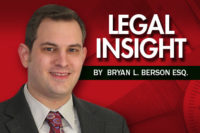A company may own a fleet of vehicles, supply some employees with a car as part of their compensation, or cover the cost of a rental for a business trip. Accidents can result in personal injury and medical expenses, long-term disability, death, and property damage. Thus, organizations should develop a system to manage and insure automobile-related risks.
First, to the extent possible, they should eliminate and avoid risk. For example, an employer that allows its employees to drive a company car or rent one at the company’s expense might require the driver to take a defensive driving course and follow traffic laws. The company should properly maintain its fleet and purchase cars with safety features (such as anti-lock brakes and airbags). Remaining risks must be insured.
A company should buy sufficient insurance coverage. A company with a lot of assets and income is likely to be sued for more than a less affluent company would be. When a company has a policy with a relatively higher liability limit, it is more likely to result in a settlement for the policy limit. For a relatively small increase in the premium, a company can substantially increase its liability limit.
Policy limits can be structured as a single limit or split limits. A split limit is divided into separate limits for (1) injury to one person, (2) injury related to a single accident regardless of the number of people injured, and (3) property damage caused by an accident. Suppose one person has a single limit policy and another person has a split limit policy, where each has a total of $600,000 in coverage. The split limit policy is split into three $200,000 components. Suppose each driver causes an accident resulting in $500,000 in personal injury to one victim and $100,000 in property damage. The driver with single limit coverage would be covered completely. The driver with split limit coverage would be covered for $200,000 of the $500,000 injury liability and all of the property damage, leaving $300,000 to be covered out of pocket.
Catastrophic injuries and death can result in substantial liability above the single person limit in a split limit policy. Legal fees are paid out of the liability limit per accident. Once that amount is exhausted, the insured must pay legal fees out of pocket. Practically, it makes sense to buy single limit coverage and an umbrella policy of at least $1 million. When buying split limit policies, one should buy a sufficiently large per person limit.
As a supplement to major medical and long-term disability insurance, car insurance may cover damages where other drivers are uninsured or under-insured. Personal injury protection coverage covers medical bills and a portion of lost wages or replacement services.
Vehicles can be damaged in a variety of ways. Collision coverage covers collision specifically, whereas comprehensive coverage covers other risks. One can choose a high deductible to obtain a lower premium. While towing and road coverage tends to be inexpensive, it is usually practical to join and use an automobile club, like AAA. It avoids extra paperwork, reimbursement delay and the need to submit additional claims.
Loss-of-use or rental coverage provides a substitute car in the event of an accident or problem. One should examine an automotive policy to see if it covers risks associated with rentals. It is wise to have a policy that covers damage to property, damage due to driver negligence, damage not caused by the driver (such as vandalism or theft), and potentially lost revenue sustained by the rental company. Regardless of whether an automotive policy covers rentals, such coverage should only be used as a backup. When renting, it is more practical to purchase an optional collision-damage waiver (CDW). In the event of an accident, it avoids the need to submit a claim to one’s personal insurance and a subsequent rate increase.
If an employee is permitted to use a company car on a regular basis, the employee should purchase an extended non-owned auto endorsement to cover injuries to coworkers and damage sustained during personal, non-business use. A personal umbrella policy will cover catastrophic injury not otherwise covered.

